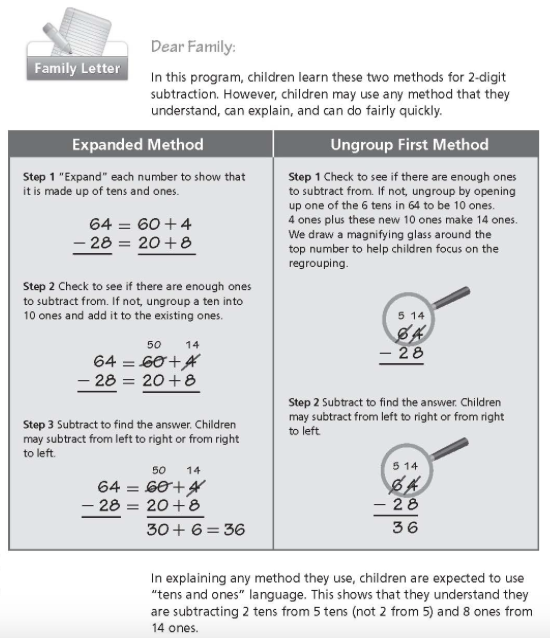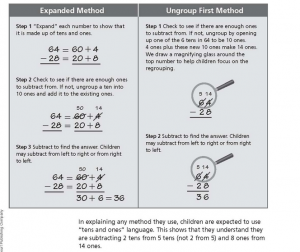Last week, we learned two strategies for how to solve two digit subtraction equations. This is a crucial skill in second grade and also something that simply takes practice to develop. The children were amazing and worked so hard! Here is an explanation of the methods that we will be using (you may want to keep handy for upcoming homework :))
Tag Archives: subtraction
Math Facts Pro!
Mastering addition and subtraction facts is a great focus in second grade. We are using an online site, MATHFACTSPRO, to aide in the memorization of facts. Just five minutes a day in the classroom provides the students with individualized math fact instruction. Children can practice at home as well. Here are the steps to access:
Log on to : http://www.mathfactspro.com/#/home
Math Update!
Our second grade mathematicians are learning how to solve multi-digit subtraction problems. Below please note the strategies that your child will be using to solve these equations. These strategies are different from how you and I learned “back in the day”, but they do promote deeper understanding of the concepts.
Updates!l
Writing Update: We spent last week working on fixing and fancying up our writing for our celebration. This whole unit focused on using other authors as mentors to learn from. So, this week we studied how other authors fancied up their stories for publication. We noticed that they have covers with titles, dedication pages, and about the author pages. And just like them, we tried it too! If the stories don’t entertain you, the about the authors pages will! We will celebrate this week.
Social Studies Update: We have been talking about the past, present, and future. We learned that kindergarten is in the past, 1st grade is the present, and in the future, we will be in 2nd grade. We are learning about history, and history is the study of the past. There are four ways to learn about the past: Pictures, People, Written Records, Artifacts. The kids had a blast sharing family stories from the past, talking about things they did as young children, and planning what they would like to do in the future! 🙂
Math Update: Our mathematicians learned all about Picture Graphs! Our students worked with Picture Graphs that had two or more quantities! We learned that these kinds of graphs help us to organize data so that it is easier to read unlike the clump of fish and frogs shown below:
Next, they learned how to fill in a blank Picture Graph with the data drawings or pictures, similar to the ones shown above. Our mathematicians decided that it would be most helpful to cross out each frog or fish as we added them to our graph. This would ensure that we did not miss one or add too many.
We also took some time to compare the pictures on the graphs with a few questions:, Which animal has more? Which animal has fewer? How many fewer frogs are there than fish? How many more fish are there than frogs?
And to finish up our learning about these graphs, we tried to make the quantities the same number. For example, since there are more fish than frogs, you could take two fish away so that there were five fish and five frogs. You could also add two frogs to the original amount of frogs so that there were six frogs and six fish. Once our mathematicians decided which answer to go with, they wrote an equation too!
We also discussed how we should use circles to redraw our Picture Graphs because it is much easier and quicker, how even though it is not as much fun. They did such an amazing job again this week!
Math Update
Our first graders worked hard this week to prepare for our Unit 3 assessment. We spent our math switch time on Monday and part of Tuesday solving missing total, missing partner and subtraction stories using the great strategies that we’ve learned during this unit. We also practiced with our red, yellow and orange quilt cards to prepare our brains to solve all different types of equations.
The kids were definitely ready for the assessment and performed very well. Woohoo!!!
Still, they will be asked throughout the rest of this year to solve stories, and we don’t want your child to lose any of the great strategies that they’ve gained from our learning.
To support your child at home, please encourage him or her to always PROVE THEIR ANSWER when solving a story. For a missing total story, your child can write an addition equation and count on. For a subtraction story, your child can write a subtraction equation and use a circle drawing or our counting up strategy to find the answer. For a missing partner story, we have encouraged our students to make a math mountain (with the total on top) to find the answer.
We appreciate all the time that you take to encourage your child on their math homework. Practice makes permanent and we don’t want our first graders to lose these wonderful strategies!!!
Next week, we will dive into our new learning in Unit 4 which focuses on teen numbers, place value and strategies for solving equations with larger numbers. On Friday, every first grader was given a pre-test to evaluate their skills and prior knowledge to determine the best fit math group and math teacher for this new unit.
We look forward to helping your child grow even more as a mathematician!
Miss Taber 🙂
Math Update
We continued to practice our subtraction strategies during our math switch time this week. Our first graders are becoming experts at writing subtraction equations and using our counting up strategy. We are beginning to rely less and less on circle drawings… although we do encourage the use of this strategy for proving our answers and solving equations if we are stuck.
This week we also worked with addition stories that involved finding a missing total(This type of story occurs when we know both of the partners and want to add them together). When solving a missing total story, like the one below, we’ve encouraged our students to make an addition equation and count on or to use a circle drawing. Again, the kids did such a fabulous job of listening to a story and putting the information from that story into an equation that they could solve. Check out an example of a missing total story below:
There were 2 dogs at the park. Then 4 more dogs came.
How many dogs are at the park altogether?

Here is our method for solving a coin story with a missing total:
Jen had 1 nickel and 2 pennies. Her mom gave her 2 more pennies.
How many cents does Jen have now?
We ended the week with a review of all the stories that we’ve learned how to solve:missing total, missing partner and subtraction. After reviewing our strategies for each type of story, we used our listening ears to solve a mixture of stories. (Please click here for an example of each kind of story and the strategies that your child can use to solve them.) Our students did a wonderful job listening and trying to identify what was missing; however, the toughest stories to understand and solve were definitely the ones that involved a missing partner.
As your child works their homework pages this week encourage him or her to listen for what’s missing and then pick an appropriate strategy to solve the problem. Please make sure that your child proves their work with either an equation, circle drawing or math mountain. And… especially support your child as they solve missing partner stories!!! We will be taking our Unit 3 assessment on Thursday.
Math Update
As first grade mathematicians we worked hard before break to solve missing partner and missing total addition equations. We found that if we could identify what was missing (either a partner or a total), we could use our counting on strategy to find the answer. We reviewed that theTOTAL is always the greatest number in an equation and it’s always the answer after the equals sign when we are adding. We reviewed that the PARTNERS are the smaller numbers that can be added together to make the TOTAL. Please continue to use this language with your child at home as you solve equations. The more exposure your child has to these math words the easier it will be for him or her to identify what is missing in an equation.
Since coming back to school after break, we’ve been studying subtraction again. We started the week solving subtraction stories. Our number one strategy for solving these stories has been to use an equation. However, we encouraged our students to draw a circle drawing first if they weren’t sure how to create a subtraction equation for the story. Here is an example of our methods for solving a subtraction story:
Sam had 6 cookies. He ate 2 of them.
How many cookies are left?
 We emphasized that a subtraction equation always begins with the total. We have to make sure to put the GREATEST number first so our equation and answer make sense.
We emphasized that a subtraction equation always begins with the total. We have to make sure to put the GREATEST number first so our equation and answer make sense.
We ended the week solving subtraction stories with coins, like the one below:
Jill had 1 nickel and 3 pennies. She lost 2 pennies.
How many cents does she have now?
We also learned how to use our orange quilt cards to practice solving subtraction equations using the “counting up” strategy. Since we aren’t able to write on our quilt cards, “counting up” took the place of using a circle drawing. Check out the explanation below:

Thank you for practicing with the yellow and red quilt cards at home with your child over break. Please continue to use these cards to increase your child’s speed and accuracy with their math facts. We will be sending home our orange subtraction quilt cards soon to add to your collection!
Math Update
Our first grade mathematicians worked so hard this week!!!
We began our learning with a review of two games that helped us practice our counting-on strategy. Our red quilt cards trained the kids to find the larger number (clap) and count-on with the smaller number when given an addition equation. The pancake game encouraged the kids to write a missing total equation, underline the greater partner and count-on with dots to find the total. We know at school that counting-on is the best way for solving missing total equations – keep encouraging your child to use this strategy at home too!
We spent the rest of our week studying a new math concept: SUBTRACTION!!! We learned that subtraction means the same as take away. When we solve stories that involve “taking something away” we use a minus sign (-) to show what happens. For example, when given the story:
There were 5 cookies. I ate 3. How many are left?
Our first graders learned to represent this thinking with circle drawing, break-apart stick, and minus sign:
We also emphasized that a subtraction equation always begins with the total. Then we show the “minus” partner, which means that our answer is actually a missing partner (rather than a missing total like an addition equation). Our first graders “trained their brains” to count up the total and write that number first to accurately represent a subtraction story or circle drawing with an equation.
With our introduction to subtraction still very fresh and new, please support your child on their homework pages as they learn to understand the strategies involved with solving and representing subtraction stories!!!! Our learning is still fragile. We will continue to work with these concepts next week!
Miss Taber 🙂







